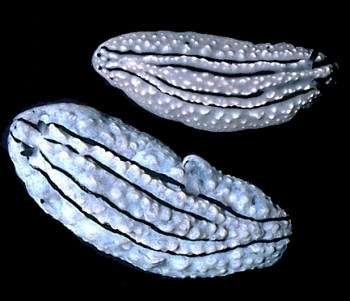
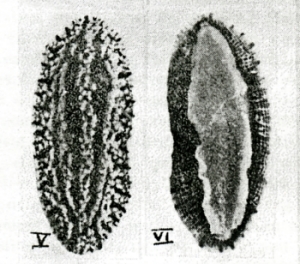
Phyllidiopsis gemmata
Pruvot-Fol, 1957
Order: NUDIBRANCHIA
Suborder: DORIDINA
Family: Phyllidiidae
DISTRIBUTION
Known from three localities in the Indian Ocean: Réunion Island; southern Thailand; and Java (type locality).
PHOTO
Upper: 16 m depth, Phi Phi Island, southern Thailand, 1 Dec. 1989, dorsal view of 30 and 38 mm specimens (Brunckhorst, 1993: Plate 7H).
Lower: Preserved specimen of P. gemmata illustrated by Pruvot-Fol (1957 - Pl. 1, figs 5, 6).
Notes compiled from Brunckhorst, 1993:
Phyllidiopsis gemmata can be distinguished in the field by its greyish pink to greyish blue tuberculate dorsum, three tuberculate ridges, four narrow black lines, fused oral tentacles with dark grey margins, dark grey coloration around the gills, and dark grey foot sole with a pale edge.
Phyllidiopsis annae and Phyllidiopsis striata also possess three median longitudinal ridges on the dorsum. Phyllidiopsis striata is a smaller species with white and black coloration (white ventrally), and lemon yellow rhinophores. The dorsal ridges of P. annae are bright blue and granular in appearance with minute, isolated tubercles (very tuberculate and grey in P. gemmata). Phyllidiopsis annae has black rhinophores and uniform grey coloration ventrally (except for the small oral tentacles which are dark grey to black). Furthermore, P. annae is a smaller species.
Note added 20 Dec. 2006: The specimen illustrated in Pruvot-Fol's original description of P. gemmata [Pl. 1, figs 5,6] shows radial, or transverse, lines around the mantle edge. She does not mention these lines in her descriptions and neither does Brunckhorst (1993). The specimens illustrated by Brunckhorst [see photo above right] do not show these lines. See messages below from Reunion Island and Mauritius [ #19024,#19025, #19038 ] suggesting that radial lines around the mantle edge are probably chracteristic of the species.
-
Brunckhorst, D. J. (1993) The systematics and phylogeny of Phyllidiid Nudibranchs (Doridoidea). Records of the Australian Museum, Supplement 16: 1-107.
-
Pruvot-Fol, A. (1957) Révision de la famille des Phyllidiadae. 2. Journal de Conchyliologie, 97: 104-135, Pl.1.
Rudman, W.B., 1999 (August 1) Phyllidiopsis gemmata Pruvot-Fol, 1957. [In] Sea Slug Forum. Australian Museum, Sydney. Available from http://www.seaslugforum.net/find/phylgemm
Related messages
Phyllidiopsis gemmata from Tofo, Mozambique
August 13, 2007
From: Natasja Vandeperre
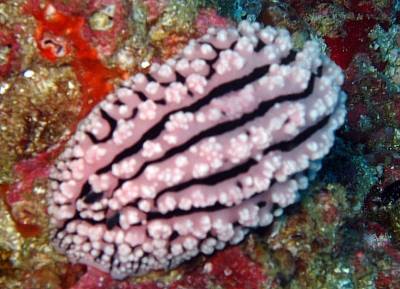
Dear Bill,
Is this Phyllidiopsis krempfi? Just looking at it under water it had a green color. On the picture though the colour is pink.
Locality: Tofo, Mozambique, Indian Ocean, 16 July 2007. Photographer: Natasja Vandeperre.
Greetings,
Natasja
postmaster@naaktslakken.be
Vandeperre, N., 2007 (Aug 13) Phyllidiopsis gemmata from Tofo, Mozambique. [Message in] Sea Slug Forum. Australian Museum, Sydney. Available from http://www.seaslugforum.net/find/20412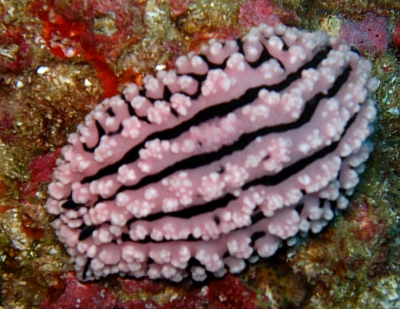
Dear Natasja,
I am pretty sure this is Phyllidiopsis gemmata. The shift in colour from pink to green is found in species of both Phyllidiella and Phyllidiopsis. I am sure it is not just a trick of light. It may have something to do with the physics of light but it not just a question of the spectral colours and water depth. I have taken green and pink animals of Phyllidiella back to the lab to photograph together only to have them all go pink before I could get my camera set up.
And see the two Phyllidiella pustulosa in message #19118 ].
Best wishes,
Bill Rudman
Phyllidiopsis gemmata from Reunion Island
December 20, 2006
From: Philibert Bidgrain
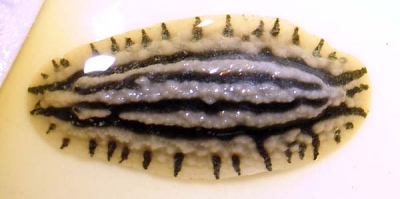
Dear Bill,
We have found a lot of specimens of Phyllidiopsis gemmata, and all of them present a little variation from the original description of this species.
They have some little black stripes around the animal in the marginal band.
I never see such pattern in specimen from another country
Locality: 5 to 20 m, Reunion Island, Indian Ocean
What's your opinion about this remark? Have you already see such pattern variation ?
Philibert Bidgrain
http://vieoceane.free.fr/runseaslug/indexslug.htm
vieoceane@free.fr
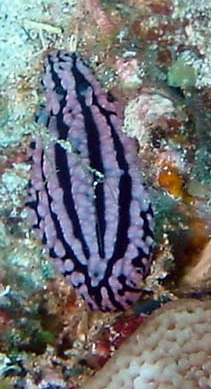
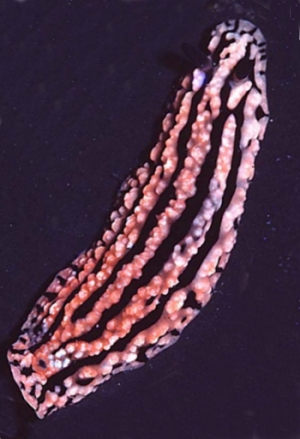

Dear Philibert,
After receiving the Flodrops' recent messages, and then yours, I thought I had better check up on Pruvot-Fol's original description of P. gemmata and was surprised to find that the specimen she illustrates has the radial, or transverse, lines around the mantle edge as in your specimens. So far from being unusual, it appears your animals are 'typical' and the one which Brunckhorst illustrates and describes in his monograph [see species Fact Sheet] is the unusual one. Pruvot-Fol does not give any locality data in her description of this species - except for mentioning it was in a vial in the British Museum - but Brunckhorst, who studied the British Museum material, gives Java as the locality of the type material. Pruvot-Fol does not mention the radial lines either, but they are clearly visible in her photograph, which I have reproduced here.
So I guess I can now confidently say your animals are P. gemmata.
Pruvot-Fol, A. (1957) Révision de la famille des Phyllidiadae. 2. Journal de Conchyliologie, 97: 104-135, Pl.1.
Best wishes,
Bill Rudman
Phyllidiopsis gemmata? from Mauritius
December 18, 2006
From: Hugues Flodrops
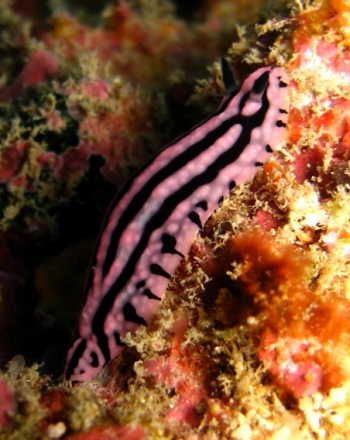
Dear Bill,
Here are two others specimens of Phyllidiopsis gemmata found under the same rock in Mauritius. The characteristics are similar to P. gemmata from Reunion, also with transverse black rays around the mantle edge [see message #19024 ].
Locality: Ilot Tamarin, Flic and Flac, 16 metres, Mauritius, Indian Ocean, 20 November 2006. Length: First 40 mm, Second 35 mm. Photographer: Hugues Flodrops.
All the specimen from "Mascareignes" seems to have these rays. Another species has three median longitudinal ridges and black spot around, it's Phyllidiopsis striata. But P. striata have usually lemon yellow rhinophore.
We think that this is a new characteristic for the species.
Thanks for your comments and for your forum.
Best regards.
Sandrine and Hugues Flodrops
hugues.flodrops@wanadoo.frs
Flodrops, S.H., 2006 (Dec 18) Phyllidiopsis gemmata? from Mauritius. [Message in] Sea Slug Forum. Australian Museum, Sydney. Available from http://www.seaslugforum.net/find/19025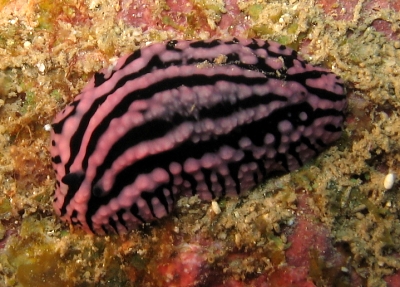
Thanks Sandrine & Hugues,
It certainly seems to have a distinctive colour pattern. I have looked at the various publications of Brunckhorst, Yonow and Schroedl and can find nothing similar, so as I said in your earlier message, I'll leave it as P. gemmatafor the time being.
Best wishes,
Bill Rudman
Phyllidiopsis gemmata? from Reunion Is
December 18, 2006
From: Hugues Flodrops
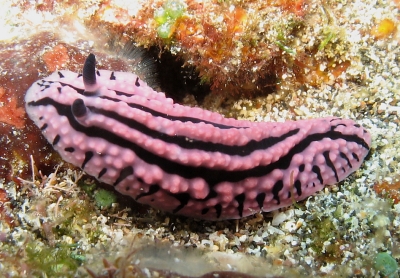
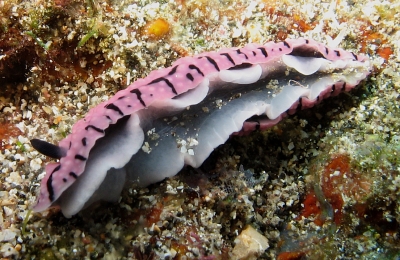
Dear Bill,
Here are two specimens of Phyllidiopsis gemmata (Pruvot-Fol,1957) caracterised by three tuberculate rides and four narrow black lines. In Reunion Island and in Mauritius (next message), we can observe transverse black rays arund the mantle edge in the four specimens found.
Locality: Upper photos: Saint-Leu, 15 metres, Reunion Island, Indian Ocean, 1 december 2006. Length: 35 mm. Photographer: Hugues Flodrops. Lower photo: St-Gilles "Canyon" Indian Ocean Depth 14 metres, specimen lenght about 30 mm. Date observed: 28 november 2006. Photographer: Hugues Flodrops.
Thanks for your comments.
Best regards.
Sandrine et Hugues Flodrops
hugues.flodrops@wanadoo.fr
Flodrops, H., 2006 (Dec 18) Phyllidiopsis gemmata? from Reunion Is. [Message in] Sea Slug Forum. Australian Museum, Sydney. Available from http://www.seaslugforum.net/find/19024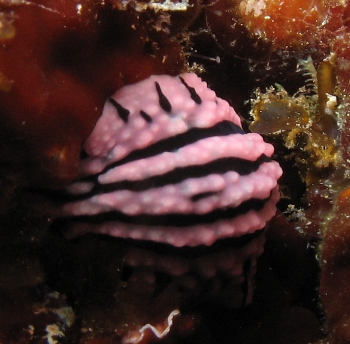
Dear Sandrine & Hugues,
Thanks for these interesting photos. In many ways this looks like a species of Phyllidiella but I know of none that looks like this. The transverse black lines are unusual, in fact I can find no record of them being observed before, so there si a chance it is a different species. However in all other features it appears to be P. gemmata so I think at this stage we will leave it there.
Best wishes,
Bill Rudman
Phyllidiopsis gemmata from Indonesia
January 7, 2002
From: Yasman
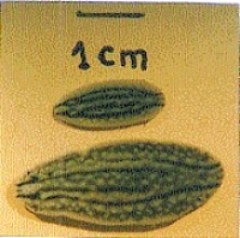
Dear Bill,
I just want to send you this photo of Phyllidiopsis gemmata. This species I found in Karang Lebar reefs, Semak Daun Island, Indonesia. It's taken on December 10 2000.
Thanks.
Yasman
y.yasman@mailcity.com
Yasman, 2002 (Jan 7) Phyllidiopsis gemmata from Indonesia. [Message in] Sea Slug Forum. Australian Museum, Sydney. Available from http://www.seaslugforum.net/find/3839Thanks Yasman,
It is a useful record,
Best wishes,
Bill Rudman
